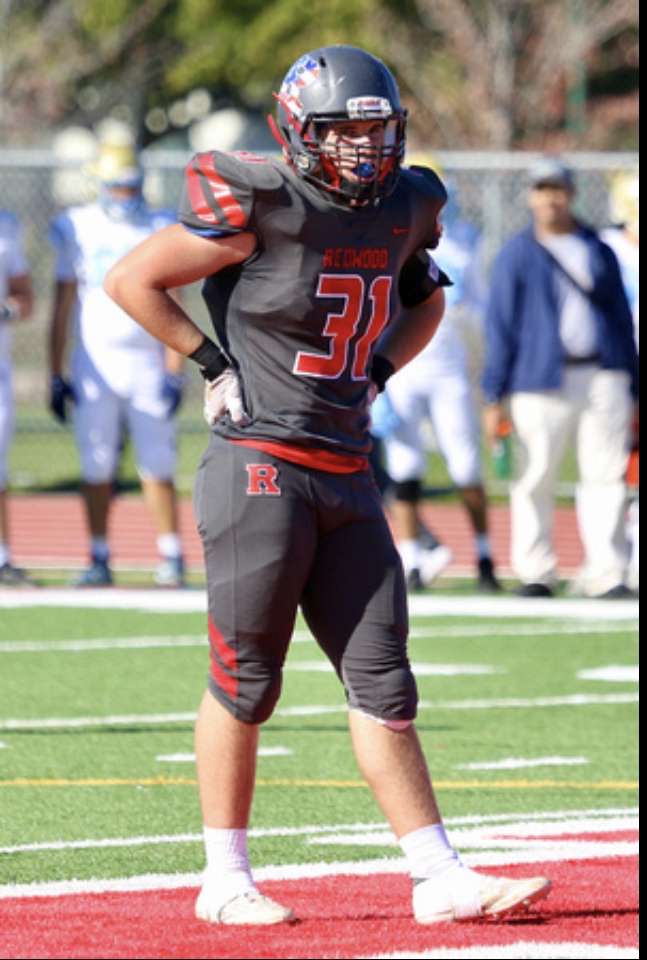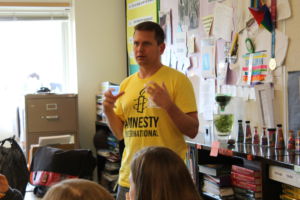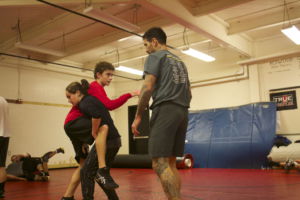The Ultimate Gated Community
January 26, 2015
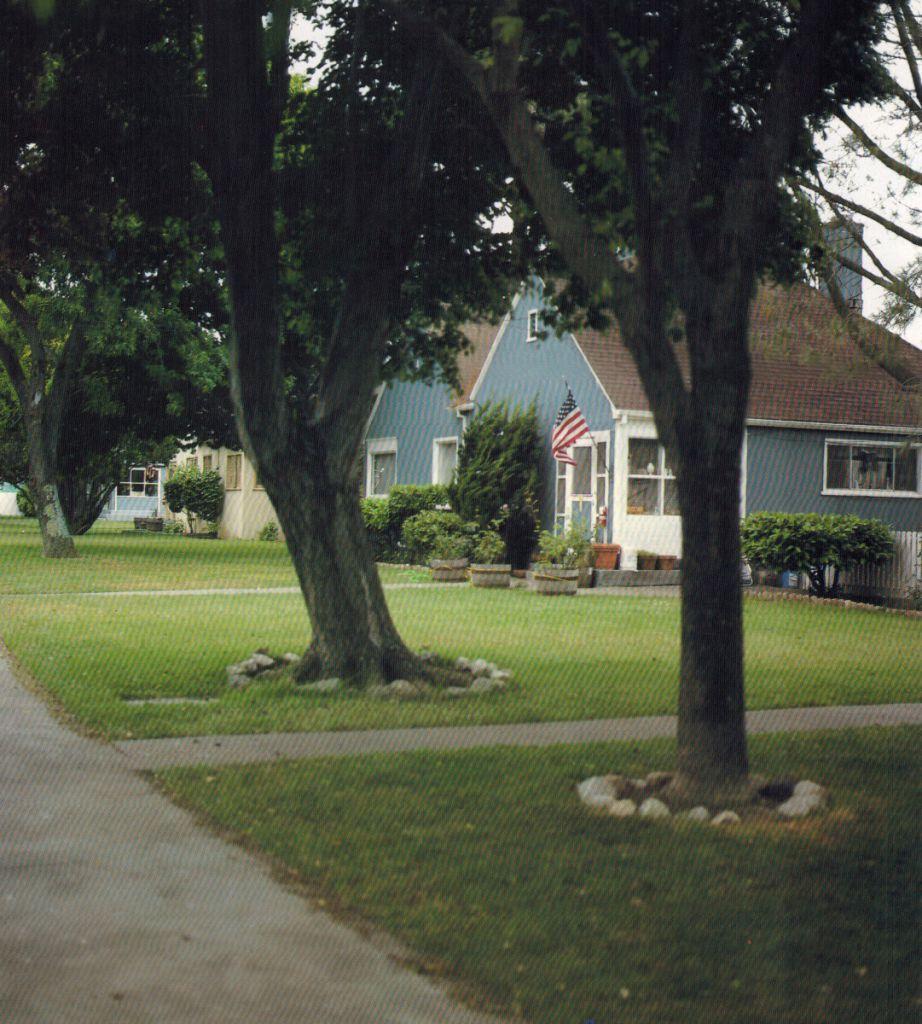
By: Chloe Wintersteen and Alex Herz
One weekend afternoon on the quiet streets of an empty track neighborhood, a boy was making rounds with his moped bike when the motor died unexpectedly. The boy — surprised that the old machine was not in working order — stopped, dismounted, and twisted a few bolts to try to get it going again.
A voice suddenly boomed from a nearby run-down taxi, which until that moment, had remained inconspicuous against the cracked exterior of the street corner. A man, bearded and tattooed, leaned out the car window, and smiling heartily, offered to help the boy with his broken-down moped.
The first thing the boy noticed as the stranger exited the car was a large wrench in his front belt loop. The second: his wrinkly prison jumpsuit.
The man stooped low, grabbed his utility tool, and after a few cranks of a broken screw, the small whirring of a rusty engine rumbled from the machine. The man gestured to the moped and smiled again, turning on his heels to retreat to the taxi. The car door shut, and the boy rolled away on his motorbike.
It did not bother the boy that the man who had helped him was a criminal. Prior to his admittance to the prison, the inmate might have kidnapped. He might have assaulted. He might even have killed. But the man was calm enough, sane enough, to help a young boy fix his moped in the middle of an empty street. It was a peculiar situation. But for the boy, not an unusual one.
Especially within the gates of San Quentin prison.

San Quentin State Prison, located along the shore of the San Francisco Bay on the outskirts of Marin County, is a California Department of Corrections and Rehabilitation detention center for men, infamous in name for holding some of society’s grandest criminals, from Charles Manson to Sirhan Sirhan.
First opened in July of 1852, San Quentin is the oldest prison in California and the only remaining facility therein that carries out court-ordered executions. Though previously ranked a Level Four security institution, the highest possible on the prison system scale, San Quentin transitioned to a Level Two title in the mid-1980s.
The majority of prison employees live within the prison gates in its residential area near the west entrance. Upon construction, its purpose was to provide a cheap and easy means for San Quentin-affiliated families to live close to their line of work, and do so at a subsidized cost.
The setting has been described as practical, affordable, and the safest place in Marin County—why, after all, would any escapee head for the most likely place of getting caught? For those whose childhoods took place inside the gates of San Quentin, however, the story is a little less black and white.
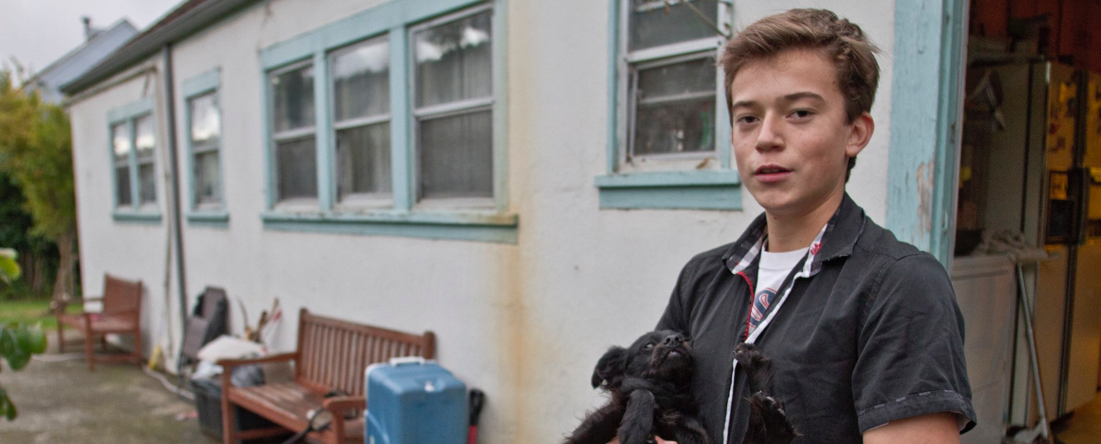
Sophomore Julian Erickson currently lives in one of the on-grounds residencies within the gates of San Quentin. His father, Peter Erickson, works for the prison as a correctional captain.
The Erickson family moved to San Quentin when Julian was in third grade. Peter had been working at Avenol prison, but was offered a promotion to a lieutenant position at San Quentin. What initially enticed Peter to move inside the San Quentin grounds was the cheap housing costs.
“The houses here are available to staff members at the convenience of the warden. He uses the houses here as an incentive to draw talent to the institution,” Peter said. “There are a number of people that are in these houses that if they didn’t have basically subsidized housing they could not afford to work here at the institution.”
Peter described San Quentin residential neighborhood as incredibly safe, and is comforted by the notion that his son will always be protected while inside the gates.
“It’s a gated community,” Peter said. “I feel a lot safer here than I would on the outside. On the outside, you don’t have any control over who walks across your sidewalk, but here I know there are two guards who are preventing unwanted people from just wandering into the on-grounds residencies.”
However, Peter added that the top-notch security system can sometimes protect the on-grounds residents too well.
“On the other hand, it can also be a pain in the butt because every time I leave the institution I have someone who opens and shuts my trunk,” Peter said. “Their job is to keep people out who don’t belong here, but my wife, for example, left without her identification and she couldn’t get back on grounds to get her purse.”
Security measures are anything but precautionary. Inmates, in certain circumstances, are allowed to work inside the residential grounds.
According to Peter, a large classification process occurs for each inmate when they are first admitted to San Quentin. Should an inmate meet certain qualifications, he may be granted permission to work outside of the prison’s secured perimeter. When Julian’s moped broke down a few years ago, it was repaired by the on-grounds inmate taxi driver.
“Right now most of those people are working in our outside workhouses and at our fire department,” Peter said. “If you burn biscuits at 5 o’clock in the morning, you’ll have inmates walking through your house making sure there is no fire.”
However, inmate maintenance of the grounds is slowly getting reduced due to a realignment in the prison system which has been occurring over the past three years. Due to the recent realignment, the inmate work is gradually being replaced by state workers.
“It’s a double edged sword because all the residences are maintained at the same quality that you’d find at a rest stop in the state of California,” Peter said.
Since San Quentin is a government run institution, any changes to the homes must be requested to the institution through their bureaucratic work order process; a process which requires a large amount of paperwork.
“They’re simple decisions [that require paperwork.] If I wanted to pull up that tree right there, first I’d have to send in a request to remove the tree, and I don’t like that tree and I’d like to see it gone, but the one thing I hate worse than that tree is all of the paperwork. And so I leave that tree,” Peter lamented.
The reverse issue occurred when a potted peach tree in the Erickson family’s backyard grew more than previously expected. “Its roots got into the soil, so it’s considered government property now and I can’t take it out of the ground,” Julian said.
The San Quentin neighborhood is like an island. While residing within the San Quentin gates could have been perceived as an isolating experience in the past, according to Julian, the growing prevalence of technology has made it easier for residents to stay connected with friends who live outside of the gates.
“If you’d rather talk face to face with someone, then [living here] is probably going to affect you negatively,” Julian said. “But if you’re like me and you really don’t want to talk to anyone when you go home and all you want to do is watch Netflix and get in some sweats, then it’s fine.”
The aspect of living in San Quentin that provides Julian with the most stress is not related to the prison itself, but rather the pressure of his annual district transfer to Redwood. Since the San Quentin neighborhood technically lies within the San Rafael school district, Julian is required to reapply to Redwood each year. If he should to qualify for a transfer renewal, he will be required to attend San Rafael High School.
“The contract that you have going to Redwood is very strict. They want you to maintain a particular grade point average, you can’t be a delinquent, you can’t be tardy. In that respect I think it puts a lot of stress on Julian,” Peter said.
Stress is also frequent in Peter’s line of work. Peter doesn’t believe violence would be inflicted upon his family by an inmate, though he does worry about the consequences which might occur should an inmate accidentally be released into the outside community.
“I don’t fear the violence that might occur in the institution, but somebody escaping or the incidental or accidental release of somebody into the community and having an innocent person harmed, that’s disconcerting,” Peter said.
Violence within the prison itself, however, is fairly commonplace, and Peter has witnessed numerous brawls and altercations between inmates while on duty.
“I watched an inmate get his throat slashed right in front of me. He didn’t bleed immediately. I walked him over to the bathroom and it wasn’t until he looked in the mirror that his neck gaped open. It missed all of his veins and arteries, it was amazing.”
Peter acknowledged that not all inmates are particularly vengeful, however. Many times inmates are admitted into the prison system as a result of a few bad decisions.
“They’re average people that for one reason or another get to a point in their life where they have this ‘oh shit’ moment where everything goes wrong; it could be drug related, alcohol related, or a domestic violence issue, but that doesn’t necessarily mean they’re particularly violent or that they’re constantly a menace to society,” Peter said. “But as I say that, understand that there are people in this world like a Hannibal Lecter who are predacious.”
Peter admitted that the stressful nature of his job has affected his home environment. “Since I was promoted from Lieutenant to Captain, my son and my wife have both told me that I’m no fun anymore,” said Peter.
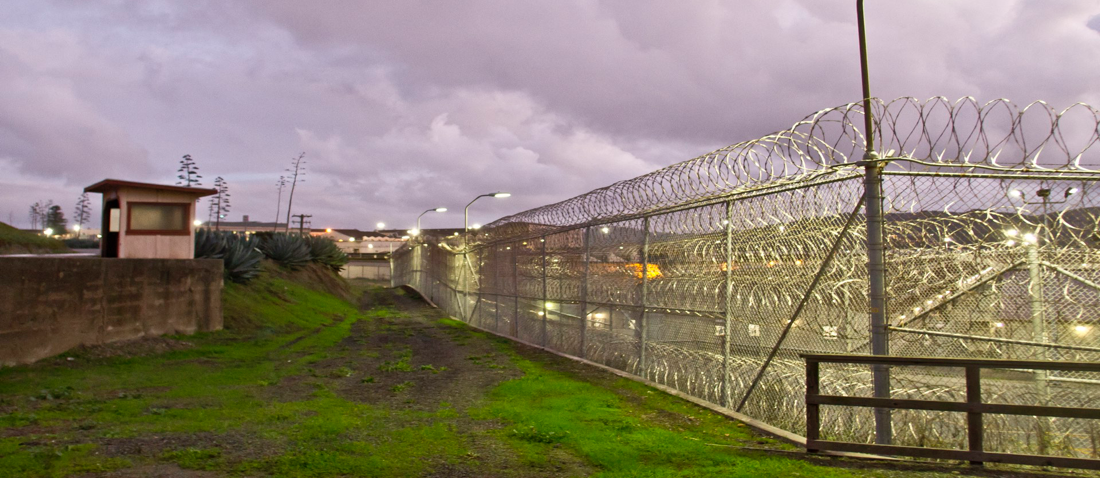
The effects that work inside the prison has on employees and their families is not just restricted to on-grounds residents alone. Allison Kreshin, a local child psychiatrist and former Redwood High School parent, worked in San Quentin in 2011 for one year as an inmate psychiatrist. Kreshin shared that her experience was unlike anything she’d undertaken before.
“I remember when I first showed up and I signed in on the first day. You have to go through this gate and this port, like the opening to the old “Get Smart” where one door opens and another door opens,” Kreshin said. “When I signed in they said, ‘Y’know, doctor, if you’re taken hostage we do not negotiate.’ And I said ‘Oh, thank you very much, here we go!’”
Similar to Peter’s assessment, Kreshin attested that there were a wide range of inmate personalities which she dealt with each day.
“Some of the men were like the scum of the earth, and some of the men….it absolutely blew me away how they could still experience that day when they would wake up and feel like it was worth being alive, even if they had no possibility of parole,” Kreshin said.
When it came to dealing with the more dangerous inmates, Kreshin said her normal psychiatric techniques weren’t all that applicable.
“I saw one man who was psychotic. He was in cuffs and ankle cuffs and he had a shower cap on his head and chains around his neck,” Kreshin said. “When I saw him, there were at least four correctional officers with me the whole time. So much for confidentiality.”
The contrast between the harsh, rigid nature of San Quentin and the beauty of the surrounding county was, according to Kreshin, the strangest aspect of working in the prison.
“My office window looked out West, and I could see my neighbor’s house from the San Quentin hospital,” Kreshin said, “My office also looked out over the yard. So it was like, there’s the men in the fenced-off San Quentin peninsula playing ball, and then I’d look beyond and I could see Mt. Tam and our beautiful town. It blew my mind.”
According to Kreshin, the stress she experienced in her work environment was mirrored at home, but not extensively.
“I think my kids and husband felt it,” Kreshin said. “But it wasn’t too bad.”
What ultimately encouraged Kreshin to quit her job, however, was not the stressful work environment.
“Every morning was great seeing the men, but I quit because every afternoon I had to do about four hours of state paperwork. And I really was kind of over the paperwork after a year,” Kreshin said.
Ultimately, Kreshin felt as though the challenge of working at San Quentin was a good learning experience.
“It would rank as one of those experiences I’m glad I did. I don’t think I would do it again.”


Current Redwood High School sophomore and former San Quentin resident Dezire Celis first moved to San Quentin in the sixth grade. Though she admitted that living in such close proximity to the prison took a little getting used to at first, she ultimately described San Quentin as a safe and supportive environment to grow up in.
“When I first moved there I was freaked out because I was suddenly living next to this prison where people had committed horrible crimes. But when I got used to it, it just felt like a home,” Celis said.
Celis believes the residences within the gates could be viewed as some of the safest in all of Marin.
“It’s so protected,” Celis said. “Ever since I’ve moved away I’ve felt like I’m not as protected. I’m even more cautious of my surroundings now that I don’t live inside the gates.”
Regardless of how safe the gated community may appear, Celis said it was difficult to completely dismiss the prison’s presence.
“I was walking down this creepy road one time to give my dad lunch, and the inmates were out on their recess. A couple of them whistled and hooted and hollered,” Celis said. “One of the guards who knew me blew his whistle and called all of them back inside. If people know you there, especially the workers, they protect you and look out for you if anything happens. We’re all a big gated community family.”
Children who live inside the gates support each other as well.
“Living inside the gates made me closer to the kids in my neighborhood, and living in San Quentin definitely made it easier for me to make friends when I first moved here.” Celis said.
Celis’ father has worked within the prison system for nearly 10 years. According to Celis, the prison environment has influenced her father’s strict parenting style.
“My dad’s really strict because he knows what these guys can do. He applies what he sees and hears from these guys to what he doesn’t want me to do or get myself into,” she said.
Though both San Quentin prison and its residential areas have undergone numerous de facto transitions in recent years, the fundamental way of life has remained near constant.
[vimeo id=”https://vimeo.com/117070858″ size=”large” align=”right”]
Paula Stillman, a local Tiburon resident and San Rafael High School graduate, first moved to San Quentin in the mid-1980s when the prison still had its high-security Level Four ranking.
Stillman said that despite the picturesque suburban paradise that the residential architects had tried so hard to depict, the plastic facade fell away as soon as she scratched the surface.
“It had a good neighborhood feel, but there was a big looming monster that was the prison where all of your parents went to go off to work every day,” said Stillman. “It’s a hard thing to reconcile yourself with. You usually like to think about where you grew up as a nice warm and comfortable and safe place.”
Daily interactions with criminals were rather commonplace in the 80’s, according to Stillman.
“[They] worked on the yards, they painted the house, they were a volunteer fire department, they were everywhere. The main road through San Quentin goes right by the outside yards, so you can’t miss them,” she said.
Much like Celis, Stillman was also a victim of verbal harassment.
“There were catcalls when we were 10, 11, or 12. It’s kind of gross. If there’s something that makes you feel uncomfortable, you just skirt around it, and thats exactly what we did,” Stillman said. “San Quentin in the very early days was an uncomfortable place in vibe and attitude.”
Such a general uncomfortableness was also felt by Stillman’s mother who worked in the infirmary for the Chief Medical Officer in the innermost section of the prison.
“She said she saw Ramirez, the Night Strangler,” Stillman said of her mother, in reference to an instance in which the infirmary squad was required to remove a key from one of the famous serial killer’s orifices. “She said there’s no soul in that man’s eyes. He was one of the most frightening people she’d ever seen in her life,” Stillman recalled darkly.
This intense line of work had its definite drawbacks.
“It’s a good job. I know that some of those correctional officers were breaking six figures, but that’s overtime and I think that should be illegal,” Stillman said.
Long hours, in combination with emotionally exhausting working conditions, contributed greatly to the stress that parents brought home and, consciously or not, projected upon their families.
“My parents and my friends’ parents brought the stress home all the time. Kids are really astute and we would feel all of that,” Stillman said.
Despite the harsh realities of gate life, Stillman confessed that she could differentiate her San Quentin experience from the typical teenage experience in only a few, albeit major, ways.
“We grew up a lot faster than any of the other kids,” Stillman said. “When I was there, there was a problem with all the kids being different age ranges. The older ones often influenced the younger ones in bad ways, by bringing alcohol around and stuff like that. I think I tried alcohol a little too early, a little earlier than I would have normally.”
Stillman felt as though the gates surrounding the prison kept more in than just the inmates, and that being cut off from the rest of Marin County definitely had its drawbacks.
“We were pretty much stuck inside the gates,” she said. “If you’re in a very small-knit community, it’s harder to follow your path because it stops at the gate. You’re not finding the broader avenues in life.”
Regardless, being inside the gates meant one thing almost universally: safety. Stillman attests that, at the very least, her parents didn’t have to worry about her not coming home at night.
“I think that having such a safe environment for your children is a wonderful thing,” Stillman said. “San Quentin is the ultimate gated community.”

